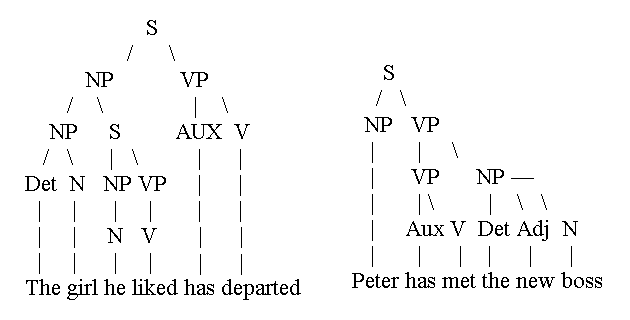




• Syntax concerns the possible arrangements of words in a language. The basic unit is the sentence which minimally consists of a main clause (containing at least a subject and verb).
• Linguists distinguish between deep structure — the level on which the unambiguous semantic structure of a sentence is represented — and surface structure — the actual form of a sentence.
• Sentence structure is normally displayed by means of a tree diagram (the so-called 'phrase structure') and by a system of re-write rules one can move from an initial unit (the entire sentence) to the individual elements (a so-called 'terminal string').
• The term generation is used in linguistics to describe exhaustively the structure of sentences. Whether it also refers to the manner in which speakers actually produce sentences, from the moment of conceiving an idea to saying a sentence, has not been finally clarified yet.
• A transformation is a change in form between the deep and the surface surface and maintains the relatedness of semantically similar sentences such as active and passive ones.
• Generative grammar can be divided into three main periods. An early one dating from Chomsky (1957), a central one which was initiated by Chomsky (1965) and a more recent one which reached its maturity in the 1980's with the development of the government and binding model.
• Universal grammar represents an attempt to specify what structural elements are present in all languages, i.e. what is the common core, and to derive means for describing these adequately.
• Language would appear to be organised modularly. Thus syntax is basically independent of phonology for instance, though there is an interface between these two levels of language.
The purpose of analysing the internal structure of sentences is
1) to reveal the hierarchy in the ordering of elements
2) to explain how surface ambiguities come about
3) to demonstrate the relatedness of certain sentences
The hierarchical nature of the elements in sentence can be shown via ‘re-write’ rules or via tree diagrams, both of which are intended to reveal the structure which lies behind the sentence in question.


Acquisition of Syntax (greatly simplified)
Input Language heard in child‘s surroundings
Step 1 Abstraction of structures from actual sentences
Step 2 Internalisation of these structures as syntactic templates (unconscious knowledge)
Deep and surface structure
One of the most important concepts proposed by Chomsky is the concept of surface and deep structure. To indicate the nature of the structure which sentences have but which is not evident from their spoken form one uses the term deep structure and surface structure. The term surface structure has an obvious meaning. This is the actual form which a sentence has when spoken. The deep structure on the other hand is a model of the structure necessary to account for the meaning of a sentence. As mentioned above this might correspond to a map of a real but unobservable mental structure, however there is no direct proof of this.
The Generativism paradigm claims that the concept of structural analysis proposed by Structuralism paradigm is too shallow, it only reaches the level of surface structure. Surface structure can be defined as the syntactic form they take as actual sentences. In the other words, it is forms of sentences resulted from modification/ transformation. Consider these sentences:

(2)
| SD (structure describtion) :
SC
(Structural change) :
SS (Surface structure) : | 1 2 3 4
3
4 + be 2+en 1
The
door is closed by you
|
Note: the SC is
passive transformation rules
| ||
(3)
|
SD:
SC:
SS:
|
1
2 3 4
0
2 3 4
Close
the door!
|
Note: 0 is deletion
| ||

Website design / content / graphics by Fakhar Alam © 2015 Prof. Fakhar Alam